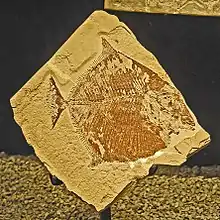| Palaeobalistum | |
|---|---|
 | |
| Palaeobalistum goedeli from Lebanon. Cretaceous (abt. 95 Ma) | |
| Scientific classification | |
| Kingdom: | |
| Phylum: | |
| Class: | |
| Order: | |
| Family: | |
| Genus: | Palaeobalistum Blainville 1818 [1] |
| Species | |
|
See text | |
Palaeobalistum is an extinct genus of prehistoric ray-finned fish which ranged from the Cretaceous to Eocene periods.[2]
Etymology
The Latin genus name derives from a Greek word meaning "thick tooth".[3]
Species
The following species have been described:[4]
- Palaeobalistum dossantosi Maury, 1930
- Palaeobalistum flavellatum Cope, 1886
- Palaeobalistum geiseri Thurmond, 1974
- Palaeobalistum goedeli Heckel, 1856[5]
- Palaeobalistum gutturosum Arambourg, 1954
- Palaeobalistum libanicum Kramberger, 1895
- Palaeobalistum orbiculatum Blainville, 1818
- Palaeobalistum ponsortii Heckel, 1854
- Palaeobalistum rectidens Thurmond, 1974
- Palaeobalistum zignoi Blot, 1987
Distribution
Fossils of Palaeobalistum have been found in:[6]
- Cretaceous
- Gramame Formation, Brazil
- Greenhorn Limestone, Colorado
- Antlers Formation, Oklahoma
- Glen Rose, Paluxy and Walnut Formations, Texas
- Haqel Limestone, Lebanon[5]
- Eocene
See also
References
This article is issued from Wikipedia. The text is licensed under Creative Commons - Attribution - Sharealike. Additional terms may apply for the media files.
